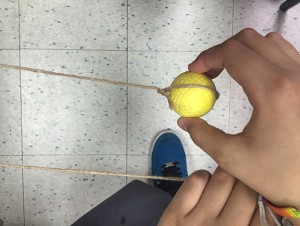Last week, our young men began to learn about the role that energy plays in golf mechanics.
In golf, energy is transferred, stored and transformed in many ways. Our muscles expend energy to raise the golf club, which stores gravitational potential energy. As we swing, that stored gravitational energy and the body’s muscles accelerate the club, which transfers kinetic energy into the club.
The students experimented with a golf ball in a gravity well (above), noting how its energy is dissipated over time. We also did a stacked-ball-drop demonstration, in which we held a golf ball on top of a basketball and dropped them at the same time. The golf ball bounced much higher than it did when dropped by itself. This showed the students that energy can be transformed from gravitational to kinetic to elastic and finally back into kinetic and gravitational energy.
Our students also began to study the pendulum, a key concept for understanding golf swing mechanics. Each team constructed two golf-ball pendulums, hanging side-by-side from the same taut twine. They observed the motion of the swinging pendulums and also how the initial energy stored in one pendulum can be transferred back and forth between the two in a periodic manner.
If the two pendulums are at rest, and you set one into motion, it will transfer its energy through the twine to the other pendulum, setting it into motion. When the first pendulum is swinging at its maximum height (greatest amplitude), the other is still; when it is swinging at its minimum height (lowest amplitude), the other swings with its greatest amplitude.
This week, our young men will continue to learn about energy conservation by experimenting with golf club pendulums and studying the game from the first tee shot to the final putt.
